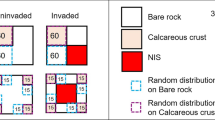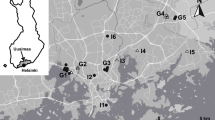Abstract
The connectivity of fragmented landscapes is a function of the physical distance between suitable habitats and the characteristics of the habitat through which the animal is moving, i.e. the matrix. Experimental manipulations done to explain how spatial arrangement and composition of habitats affects biota remain scarce, particularly in marine systems. Holdfasts of the common kelp, Ecklonia radiata, are discrete units of habitat for small invertebrates (e.g. amphipods, isopods, molluscs, annelids) that can be isolated from other holdfasts by habitat, which may be less suitable (e.g. other species of algae or relatively bare space). We compared assemblages, which colonised defaunated holdfasts in experimentally created small-scale landscapes where patches of habitat (holdfasts) were distant versus close together and which had Sargassum spp. versus relatively bare space in the matrix. We also compared colonisation across matrices of crushed fucoid algae to assess whether the structural or chemical nature of algae in the matrix had the most influence on the colonisation. Assemblages in defaunted holdfasts differed between those that were close to and those that were distant from undisturbed holdfasts, where the matrix was devoid of vegetation. Where Sargassum spp. was present in the matrix, however, this difference disappeared and was possibly due to the chemical, rather than structural, characteristics of the fucoid matrix. The extent to which matrix habitat is a barrier to movement of invertebrates among holdfasts thus depends on not only how extensive it is but what type of habitat it contains. As within terrestrial systems, the nature of the matrix is also likely to be a fundamental component of the connectivity within marine systems.




Similar content being viewed by others
References
Anderson MJ (2001) A new method for non-parametric analysis of variance in ecology. Aust Ecol 26:32–46
Anderson MJ (2005) PERMANOVA: a FORTRAN computer program for permutational multivariate analysis of variance., Department of Statistics, University of Auckland, New Zealand
Andrén H (1994) Effects of habitat fragmentation on birds and mammals in landscapes with different proportions of suitable habitat: a review. Oikos 71:355–366
Ås S (1999) Invasion of matrix species in small habitat patches. Conserv Ecol 3:1 (online) URL: http://www.consecol.org/vol3/iss1/art1
Bell SS, Brooks RA, Robbins BD, Fonseca MS, Hall MO (2001) Faunal response to fragmentation in seagrass habitats: implications for seagrass conservation. Biol Conserv 100:115–123
Bender DJ, Fahrig L (2005) Matrix structure obscures the relationship between interpatch movement and patch size and isolation. Ecology 86:1023–1033
Brown JH, Kodric-Brown A (1977) Turnover rates in insular biogeography: effect of immigration on extinction. Ecology 58:445–449
Brown GP, Phillips BL, Webb JK, Shine R (2006) Toad on the road: use of roads as dispersal corridors by cane toads (Bufo marinus) at an invasion front in tropical Australia. Biol Conserv 133:88–94
Chapman MG (1998) Relationships between spatial patterns of benthic assemblages in a mangrove forest using different levels of taxonomic resolution. Mar Ecol Prog Ser 162:71–78
Clarke KR (1993) Non-parametric multivariate anlayses of changes in community structure. Aust J Ecol 18:117–143
Collinge SK, Forman RTT (1998) A conceptual model of land conversion process: predictions and evidence from a microlandscape experiment with grassland insects. Oikos 82:66–84
Connell SD (2007) Water quality and the loss of coral reefs and kelp forests: alternative states and the influence of fishing. In: Connell SD, Gillanders BM (eds) Marine ecology, Oxford University Press, Melbourne, pp 556–568
Edgar GJ (1991) Artificial algae as habitats for mobile epifaunal factors affecting colonization in a Japanese Sargassum bed. Hydrobiologia 226:111–118
Edgar GJ (1992) Patterns of colonization of mobile epifauna in a Western Australian seagrass bed. J Exp Mar Biol Ecol 157:225–246
Eggleston DB, Elis WE, Etherington LL, Dahlgren CP, Posey MH (1999) Organism response to habitat fragmentation and diversity: habitat colonization by estuarine macrofauna. J Exp Mar Biol Ecol 236:107–132
Fahrig L (2002) Effect of habitat fragmentation on the extinction threshold: a synthesis. Ecol Appl 12:346–353
Fahrig L (2003) Effects of habitat fragmentation on biodiversity. Annu Rev Ecol Syst 34:487–515
Franz DR, Mohamed Y (1989) Short-distance dispersal in a fouling community amphipod crustacean, Jassa marmorata Holmes. J Exp Mar Biol Ecol 133:1–13
Freemark KE, Merriam G (1986) Importance of area and habitat heterogeneity to bird assemblages in temperate forest fragments. Biol Conserv 36:115–141
Gascon C, Lovejoy TE, Bierregaard RO Jr, Malcom JR, Stouffer PC, Vasconcelos HL, Laurance WF, Zimmerman B, Tocher M, Borges S (1999) Matrix habitat and species richness in tropical forest remnants. Biol Conserv 91:223–229
Gray JS, Aschan M, Carr MR, Clarke KR, Pearson TH, Rosenburg R, Warwick RM (1998) Analysis of community attributes of the benthic macrofauna of the Frierfjord/Langesundfjord and in a mesocosm experiment. Mar Ecol Prog Ser 46:285–299
Goodsell PJ, Connell SD (2002) Can habitat loss be treated independently of habitat configuration? Implications for rare and common taxa in fragmented landscapes. Mar Ecol Prog Ser 239:37–44
Goodsell PJ, Connell SD (2005) Historical configuration of habitat influences the effects of disturbance on mobile invertebrates. Mar Ecol Prog Ser 299:79–87
Goodsell PJ, Fowler-Walker MJ, Gillanders BM, Connell SD (2004) Variations in the configuration of algae in subtidal forests: implications for invertebrate assemblages. Aust Ecol 29:350–357
Goodsell PJ, Chapman MG, Underwood AJ (2008) Differences between biota in anthropogenically fragmented and in naturally patchy habitats. Mar Ecol Prog Ser (in press)
Gower JC (1971) A general coefficient of similarity and some of its properties. Biometrics 27:857–871
Gunnill FC (1982a) Macroalgae as habitat patch islands for Scutellidium lamellipes (Copepoda: Harpacticoida) and Ampithoe tea (Amphipoda: Gammaridae). Mar Biol 69:103–116
Gunnill FC (1982b) Effects of plant size and distribution on the numbers of invertebrate species and individuals inhabiting the brown alga Pelvetia fastigiata. Mar Biol 69:263–280
Hanski I (1994) Patch-occupancy dynamics in fragmented landscapes. Trends Ecol Evol 9:131–135
Hanski I, Alho J, Moilanen A (2000) Estimating the parameters of survival and migration of individuals in metapopulations. Ecology 81:239–251
Henle K, Lindenmayer DB, Margules CR, Saunders DA, Wissel C (2004) Species survival in fragmented landscapes: where are we now? Biodivers Conserv 13:1–8
Howard RK (1985) Measurements of short-term turnover of epifauna within seagrass beds using an in situ staining method. Mar Ecol Prog Ser 22:163–168
Holmquist JG (1998) Permeabililty of patch boundaries to benthic invertebrates: influences of boundary constrast, light levels and faunal density and mobility. Oikos 81:558–566
Johnson AR, Wiens JA, Milne BT, Crist TO (1992) Animal movements and population dynamics in heterogenous landscapes. Landsc Ecol 7:63–75
Lawton JH (1994) What do species do in ecosystems? Oikos 71:367–374
Lee M, Fahrig L, Freemark KE, Currie DJ (2002) Importance of patch scale vs landscape scale on selected forest birds. Oikos 96:110–118
MacArthur RH, Wilson E (1967) The equilibrium theory of island biogeography. Princeton University Press, Princeton
McGarigal K, Cushman S (2002) Comparative evaluation of experimental approaches to the study of habitat fragmentation effects. Ecol Appl 12:335–345
Murphy HT, Lovett-Doust J (2004) Context and connectivity in plant metapopulations and landscape mosaics: does the matrix matter? Oikos 105:3–14
Norderhaug KM, Christie H, Rinde E (2002) Colonisation of kelp imitations by epiphyte and holdfast fauna; a study of mobility patterns. Mar Biol 141:965–973
Parker JD, Duffy E, Orth RJ (2001) Plant species diversity and composition: experimental effects on marine epifaunal assemblages. Mar Ecol Prog Ser 224:55–67
Poore AGB (2004) Spatial associations among algae affect host use in a herbivorous marine amphipod. Oecologia 140:104–112
Poore AB, Steinberg PD (1999) Preference-performance relationships and effects of host plant choice in an herbivorous marine amphipod. Ecol Monogr 69:443–464
Ricketts TH (2001) The matrix matters: effective isolation in fragmented landscapes. Am Nat 158:87–99
Roberts DA, Poore AGB (2006) Habitat configuration affects colonisation of epifauna in a marine algal bed. Biol Conserv 127:18–26
Smith SDA, Simpson RD, Cairns SC (1996) The macrofaunal community of Ecklonia radiata holdfasts: description of the faunal assemblage and variation associated with differences in holdfast volume. Aust J Ecol 21:81–95
Tanner JE (2006) Landscape ecology of interactions between seagrass and mobile epifauna: the matrix matters. Estuar Coast Shelf Sci 68:404–412
Taylor RB (1998) Short-term dynamics of a seaweed epifaunal assemblage. J Exp Mar Biol Ecol 227:67–82
Taylor RB, Cole RG (1994) Mobile epifauna on subtidal brown seaweeds in northeastern New Zealand. Mar Ecol Prog Ser 115:271–282
Taylor PD, Fahrig L, Henein K, Merriam G (1993) Connectivity is a vital element of landscape structure. Oikos 68:571–573
Tischendorf L, Grez A, Zaviezo T, Fahrig L (2005) Mechanisms affecting population density in fragmented habitat. Ecol Soc 10:7 (online) URL: http://www.ecologyandsociety.org/vol10/iss11/art10/
Vandermeer J, Carvajal R (2001) Metapopulation dynamics and the quality of the matrix. Am Nat 158:211–220
Virnstein RW, Curran MC (1986) Colonization of artificial seagrass versus time and distance from source. Mar Ecol Prog Ser 29:279–288
Wiens JA (1992) Ecological flows across landscape boundaries: a conceptual overveiw. In: Hansen AJ, di Castro F (eds) Landscape boundaries: consequences for biotic dievrsity and ecological flows. Springer, New York, pp 217–235
Wiens JA (2002) Riverine landscapes: taking landscape ecology into the water. Freshw Biol 47:501–515
Wiens JA, Milne BT (1989) Scaling of “landscapes” in landscape ecology or landscape ecology from a beetles perspective. Landsc Ecol 3:87–96
Witman JD, Dayton PK (2001) Rocky subtidal communities. In: Bertness MD, Gaines SD, Hay ME (eds) Marine community ecology. Sinauer Associates, Sunderland, pp 339–366
Yassini I, Jones BG, King RJ, Ayress M, Dewi KT (1995) Ostracod fauna associated with sublittoral kelp forest vegetation at Windang Island, NSW, Australia. Mar Freshw Res 46:1181–1194
Acknowledgments
We are very grateful to E. Vytopil, P. Anderson and K. Rouse for help with the painstaking fieldwork. Thanks to M. Thiel and anonymous reviewers for helpful comments that improved the manuscript. This research was supported by postgraduate awards to PJG and an Australian Research Council grant to SDC. The research complies with the current laws of Australia.
Author information
Authors and Affiliations
Corresponding author
Additional information
Communicated by M. Wahl.
Rights and permissions
About this article
Cite this article
Goodsell, P.J., Connell, S.D. Complexity in the relationship between matrix composition and inter-patch distance in fragmented habitats. Mar Biol 154, 117–125 (2008). https://doi.org/10.1007/s00227-008-0906-2
Received:
Accepted:
Published:
Issue Date:
DOI: https://doi.org/10.1007/s00227-008-0906-2




